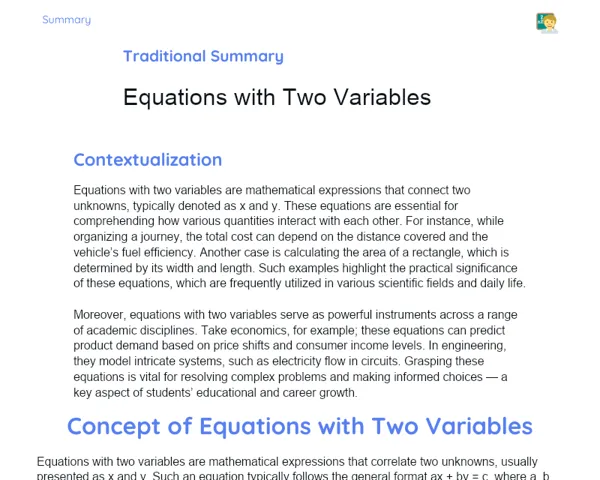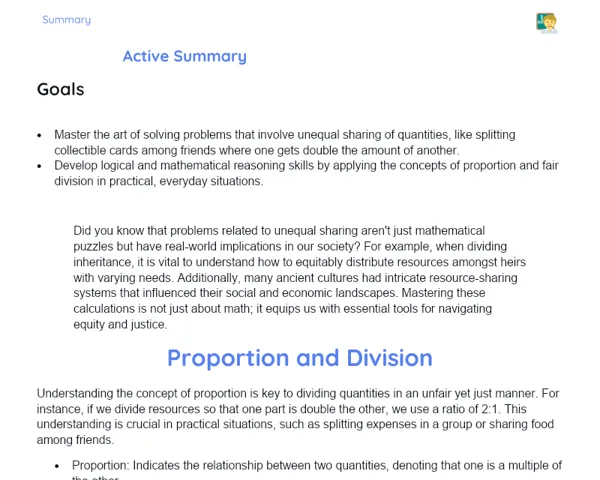Summary Tradisional | Divisibility Criteria: Review
Contextualization
Divisibility is a key concept in mathematics that simplifies problem-solving by enabling quick identification of divisors. Understanding these divisibility rules is crucial for a variety of mathematical operations, such as factoring, simplifying fractions, and identifying prime numbers. These rules offer efficient methods to check if one number divides another without complex calculations.
The divisibility rules cover specific criteria for different numbers, including 2, 3, 4, 5, 6, 7, 8, 9, 10, and 11. For instance, a number is divisible by 2 if its last digit is even, and by 3 if the sum of its digits can be divided by 3. Familiarity with and application of these rules aids in recognizing numerical patterns and streamlines mathematical computations. Additionally, these criteria find practical application in various fields, such as cryptography, which is vital for securing data.
To Remember!
Divisibility Rule for 2
A number is divisible by 2 if its last digit is 0, 2, 4, 6, or 8. This is one of the easiest divisibility rules, as it simply involves looking at the last digit. Divisibility by 2 is fundamental since it relates to the concepts of even and odd numbers, which are basic in mathematics.
Furthermore, knowing how to determine divisibility by 2 is often useful in various math operations, like simplifying fractions, where quickly identifying an even number can make things easier. In computing, this property optimizes algorithms that handle large datasets.
In practical terms, you can apply the rule of divisibility by 2 in everyday situations, like splitting a bill evenly between two people or checking if items can be shared in pairs.
-
The last digit of the number must be 0, 2, 4, 6, or 8.
-
Helps in spotting even numbers.
-
Used in simplifying fractions and computing algorithms.
Divisibility Rule for 3
To determine if a number is divisible by 3, sum all its digits and see if that sum is divisible by 3. This rule is immensely helpful as it allows you to check divisibility without doing full division. For example, for the number 123, adding 1 + 2 + 3 gives 6, which is divisible by 3, thus making 123 divisible by 3 as well.
This rule comes in handy in mathematical problems involving large numbers, streamlining the process of checking divisibility. In an educational setting, it helps students sharpen their mental math skills and understand number properties better.
Divisibility by 3 also plays a role in various advanced areas of mathematics, such as number theory, where it helps explore the characteristics of integers and their factorizations.
-
The sum of the digits must be divisible by 3.
-
Simplifies checks for divisibility without complete division.
-
Useful in math problems and number theory.
Divisibility Rule for 5
A number is divisible by 5 if its last digit is 0 or 5. This is another straightforward rule that can be quickly checked just by looking at the last digit. Divisibility by 5 is often relevant in financial calculations, such as determining if an amount can be split into 5-rupee bills.
Moreover, this rule is helpful in factoring and simplifying fractions, where spotting multiples of 5 quickens the process. In programming, this property benefits algorithms that deal with sequences of numbers or validate user inputs.
You might also encounter divisibility by 5 in organizing gatherings or events, where it aids in splitting groups or items into equal parts.
-
The last digit of the number must be 0 or 5.
-
Facilitates financial tasks and factoring.
-
Useful in programming and organizing events.
Divisibility Rule for 11
A number is considered divisible by 11 if the difference between the sum of the digits in odd positions and the sum in even positions is a multiple of 11 (including zero). For example, take 2728: adding the digits in odd positions (2 + 2 = 4) and even positions (7 + 8 = 15), the difference between these sums is 11, which is a multiple of 11, making 2728 divisible by 11.
This rule can be a bit more complex than the others but proves beneficial in specific mathematical contexts and for solving particular divisibility issues. It is frequently applied in advanced factoring tasks within number theory.
You can also apply the divisibility by 11 rule in everyday scenarios, like validating barcodes and identification numbers, where accuracy is crucial.
-
The difference between the sums of digits in odd and even positions must be a multiple of 11.
-
Useful in advanced factoring problems and number theory.
-
Applicable in validating barcodes and identification numbers.
Key Terms
-
Divisibility: The ability of a number to be split by another without leaving a remainder.
-
Divisibility Rule: Specific guidelines that help determine if one number divides another.
-
Even Numbers: Numbers that can be evenly divided by 2.
-
Sum of Digits: The process of adding all the individual digits of a number.
-
Multiple: A number that can be divided by another number without leaving a remainder.
Important Conclusions
The divisibility rules serve as essential tools for simplifying various mathematical problems. They enable quick confirmation of whether one number can be divided by another without the need for complex division, aiding in operations like factoring and simplifying fractions. Throughout the lesson, we covered divisibility rules for 2, 3, 5, 6, 7, 8, 9, 10, and 11, each accompanied by its own relevant criteria and practical uses.
Grasping these rules is crucial, not only for learning high school mathematics but also for practical applications, such as in cryptography, where they help ensure data security. Furthermore, these rules foster mental calculation skills and assist in recognizing number patterns, deepening the understanding of number properties.
I encourage you to delve deeper into this topic and apply the divisibility rules in various mathematical and real-world situations. Regular practice and embracing new challenges are key to solidifying your knowledge and honing your mathematical proficiency.
Study Tips
-
Make a habit of regularly reviewing the divisibility rules and practicing with various examples to strengthen your understanding.
-
Utilize additional resources such as educational videos and online exercises to enhance learning and visualize different approaches.
-
Create study groups to discuss and solve divisibility problems together; this can help clarify doubts and allow sharing of various solving strategies.



